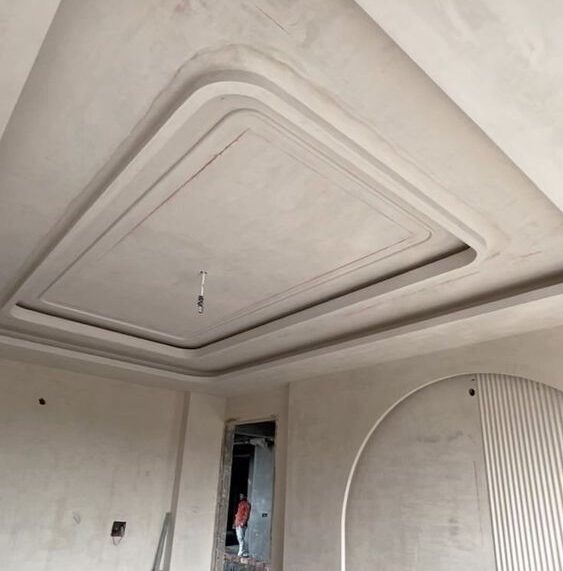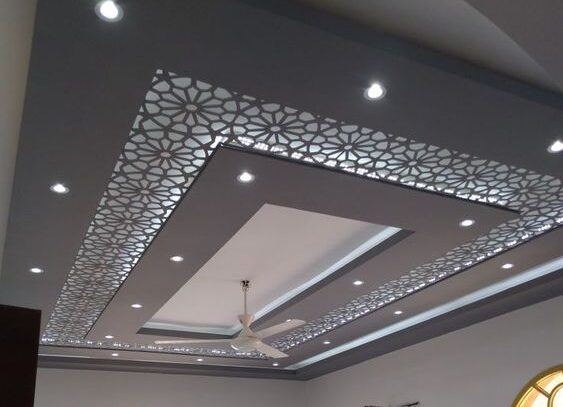Gypsum vs P.O.P False Ceiling: What’s the Difference?

Are you planning to renovate your house or office? False ceilings are a great way to add a touch of elegance to your space. False ceilings not only enhance the aesthetic appeal of the room but also offer several practical benefits. However, with different types of false ceilings available in the market, choosing the right one can be overwhelming. In this blog, we’ll discuss the key differences between two popular types of false ceilings: Gypsum false ceiling and P.O.P false ceiling.
What is a Gypsum false ceiling?

Gypsum false ceiling is made of gypsum plaster, which is a soft sulfate mineral. It is an excellent insulator and is fire-resistant. Gypsum false ceilings have a smooth surface and can be painted in any color of your choice. They are widely used in commercial and residential spaces.
Gypsum board is commonly used for walls and ceilings in residential and commercial buildings. It is available in various sizes, thicknesses, and types to meet different construction needs.

The standard sizes of gypsum boards are 8 feet x 4 feet, 10 feet x 4 feet, and 12 feet x 4 feet. The thickness of the boards varies from 6mm to 16mm, with 12.5mm being the most commonly used size for walls and ceilings. However, customized sizes of gypsum boards can also be made to meet specific construction requirements.
What is a P.O.P false ceiling?

P.O.P false ceiling is made of Plaster of Paris, which is a fine powder made by heating gypsum. P.O.P false ceilings have a rough surface and are not as strong as gypsum false ceilings. However, they are more affordable than gypsum false ceilings and can be easily molded into different shapes and designs.

Key differences between Gypsum false ceiling and P.O.P false ceiling

- Material: Gypsum false ceiling is made of gypsum plaster, while P.O.P false ceiling is made of Plaster of Paris.
- Surface: Gypsum false ceilings have a smooth surface, while P.O.P false ceilings have a rough surface.
- Strength: Gypsum false ceilings are stronger than P.O.P false ceilings.
- Fire-resistance: Gypsum false ceilings are fire-resistant, while P.O.P false ceilings are not.
- Price: P.O.P false ceilings are more affordable than gypsum false ceilings.
- Design: P.O.P false ceilings can be easily molded into different shapes and designs, while gypsum false ceilings have limited design options.
So, which one should you choose?

If you are looking for a false ceiling that is strong, fire-resistant, and has a smooth surface, go for a gypsum false ceiling. On the other hand, if you have a limited budget and want to experiment with different designs, P.O.P false ceiling is a great choice.
In conclusion, both Gypsum and P.O.P false ceilings have their own advantages and disadvantages. It ultimately depends on your preferences and requirements. Choose the one that suits your needs and budget.
Expert Design Tips for Creating Stunning False Ceilings

- Consider the purpose of the room: The design of the false ceiling should complement the purpose of the room. For example, a plain white false ceiling may work well in an office space, but it may not be suitable for a bedroom. Choose a design that suits the function and mood of the room.
- Choose the right material: The material of the false ceiling is an important factor in the design. Gypsum false ceilings have a smooth surface, while P.O.P false ceilings have a rough surface. Decide on the material that suits the look and feel of the room.
- Play with lighting: False ceilings are a great way to experiment with lighting. You can install different types of lighting fixtures to create the desired ambiance. Use indirect lighting to highlight the design of the false ceiling.
- Don’t forget the color: The color of the false ceiling should complement the overall color scheme of the room. If the walls are painted in a bold color, consider a neutral shade for the false ceiling. You can also add a pop of color to the false ceiling to make it stand out.
- Experiment with shapes: False ceilings can be molded into different shapes and designs. Don’t be afraid to experiment with curves, angles, and other geometric shapes to create a unique look. However, make sure the design doesn’t overpower the rest of the room.
- Hire a professional: Installing a false ceiling requires expertise and experience. Hire a professional to ensure that the design is executed properly and safely.
FAQs
1. What is the best material for false ceiling design?
The best material for false ceiling design depends on the specific requirements of the space. Gypsum and P.O.P are popular choices due to their affordability, fire resistance, and sound insulation properties. However, other materials such as metal, wood, and PVC can also be used.
2. How much does it cost to install a false ceiling?
The cost of installing a false ceiling depends on several factors such as the size of the room, the material used, the design, and the labor charges. On average, the cost can range from Rs. 150 to Rs. 200 per square foot.
3. What types of lighting fixtures can be used in false ceilings?
A wide variety of lighting fixtures can be used in false ceilings. Some popular options include recessed lights, track lights, pendant lights, and chandeliers. Indirect lighting can also be used to highlight the design of the false ceiling.

